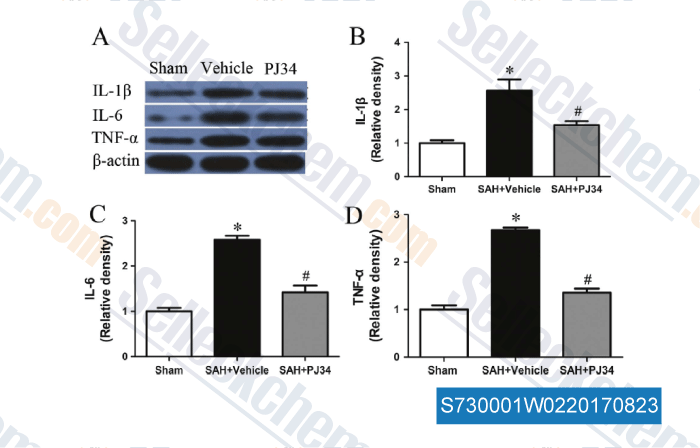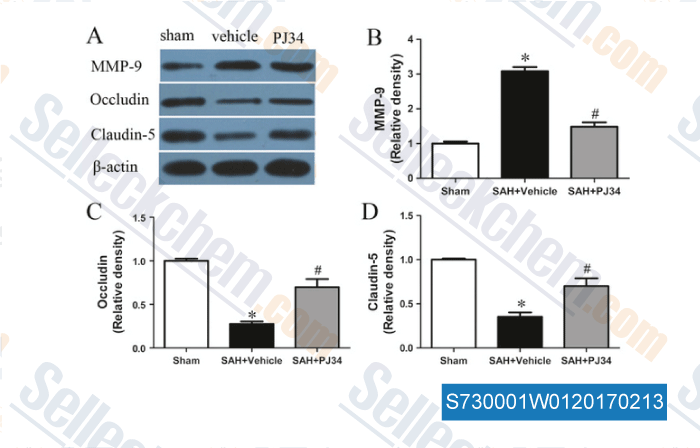|
Toll Free: (877) 796-6397 -- USA and Canada only -- |
Fax: +1-832-582-8590 Orders: +1-832-582-8158 |
Tech Support: +1-832-582-8158 Ext:3 Please provide your Order Number in the email. |
Technical Data
| Formula | C17H17N3O2.HCl |
|||
| Molecular Weight | 331.8 | CAS No. | 344458-15-7 | |
| Solubility (25°C)* | In vitro | DMSO | 66 mg/mL (198.91 mM) | |
| Water | 66 mg/mL (198.91 mM) | |||
| Ethanol | Insoluble | |||
|
* <1 mg/ml means slightly soluble or insoluble. * Please note that Selleck tests the solubility of all compounds in-house, and the actual solubility may differ slightly from published values. This is normal and is due to slight batch-to-batch variations. * Room temperature shipping (Stability testing shows this product can be shipped without any cooling measures.) |
||||
Preparing Stock Solutions
Biological Activity
| Description | PJ34 HCl is the hydrochloride salt of PJ34, which is a PARP inhibitor with EC50 of 20 nM and is equally potent to PARP1/2. | ||
|---|---|---|---|
| Targets |
|
||
| In vitro | PJ34 is a potent, phenanthridinone PARS inhibitor, which is approximately 10,000 times more potent than the prototypical PARS inhibitor 3-aminobenzamide. PJ34 inhibited peroxynitrite-induced cell necrosis with EC50 of 20 nM. PJ34 provides cardioprotection by decreasing myocardial infarct size and enhancing postischemic regional and global functional recovery. [1] |
||
| In vivo | PJ34 suppresses the development of clinical signs of EAE in MBP-immunized PLSJL mice. PJ34 exerted therapeutic effects at the onset of EAE that are associated with reduced CNS inflammation and the maintenance of neurovascular integrity. PJ34 partially inhibits the expression of TNF-α and ICAM-1 in the Spinal Cord Tissues of MBP-Immunized Mice.[2] PJ34 provides significant, dose-dependent, anti-inflammatory effects in a variety of local inflammation models. PJ34 dose-dependently suppresses neutrophil infiltration and nitric oxide (but not KC and IL-1β) production in peritonitis. In a model of systemic endotoxemia, PJ34 pretreatment significantly reduces plasma levels of TNF-α, IL-1β and nitrite/nitrate (breakdown products of nitric oxide) production. |
||
| Features | Water-soluble PARP1/2 inhibitor with >10,000-fold potentcy vs. 3-aminobenzamide (prototypical PARP inhibitor). Potential uses in cardiovascular diseases (stroke, cerebral ischemia, & myocardial ischemia). |
Protocol (from reference)
| Animal Study: |
|
|---|
References
|
Customer Product Validation

-
Data from [Data independently produced by , , PLoS One, 2014, doi:10.1371/journal.pone.0114583]

-
Data from [Data independently produced by , , Brain Res, 2016, 1644:32-8]

-
Data from [Data independently produced by , , Brain Res, 2016, 1644:32-8.]
Selleck's PJ34 HCl has been cited by 48 publications
| STING directly interacts with PAR to promote apoptosis upon acute ionizing radiation-mediated DNA damage [ Cell Death Differ, 2025, 10.1038/s41418-025-01457-z] | PubMed: 39939798 |
| Aberrant copper metabolism and hepatic inflammation cause neurological manifestations in a mouse model of Wilson's disease [ J Neuroinflammation, 2024, 21(1):235] | PubMed: 39334421 |
| Targetable lesions and proteomes predict therapy sensitivity through disease evolution in pediatric acute lymphoblastic leukemia [ Nat Commun, 2023, 14(1):7161] | PubMed: 37989729 |
| Regulation of Rad52-dependent replication fork recovery through serine ADP-ribosylation of PolD3 [ Nat Commun, 2023, 14(1):4310] | PubMed: 37463936 |
| PARP inhibitor shuts down the global translation of thyroid cancer through promoting Pol II binding to DIMT1 pause [ Int J Biol Sci, 2023, 19(12):3970-3986] | PubMed: 37564214 |
| Nuclear DJ-1 Regulates DNA Damage Repair via the Regulation of PARP1 Activity [ Int J Mol Sci, 2023, 24(10)8651] | PubMed: 37239999 |
| Nuclear DJ-1 Regulates DNA Damage Repair via the Regulation of PARP1 Activity [ Int J Mol Sci, 2023, 24(10)8651] | PubMed: 37239999 |
| PARP14 is a novel target in STAT6 mutant follicular lymphoma [ Leukemia, 2022, 36(9):2281-2292] | PubMed: 35851155 |
| PARP14 is a novel target in STAT6 mutant follicular lymphoma [ Leukemia, 2022, 36(9):2281-2292] | PubMed: 35851155 |
| The lactate-NAD+ axis activates cancer-associated fibroblasts by downregulating p62 [ Cell Rep, 2022, 39(6):110792] | PubMed: 35545049 |
RETURN POLICY
Selleck Chemical’s Unconditional Return Policy ensures a smooth online shopping experience for our customers. If you are in any way unsatisfied with your purchase, you may return any item(s) within 7 days of receiving it. In the event of product quality issues, either protocol related or product related problems, you may return any item(s) within 365 days from the original purchase date. Please follow the instructions below when returning products.
SHIPPING AND STORAGE
Selleck products are transported at room temperature. If you receive the product at room temperature, please rest assured, the Selleck Quality Inspection Department has conducted experiments to verify that the normal temperature placement of one month will not affect the biological activity of powder products. After collecting, please store the product according to the requirements described in the datasheet. Most Selleck products are stable under the recommended conditions.
NOT FOR HUMAN, VETERINARY DIAGNOSTIC OR THERAPEUTIC USE.
